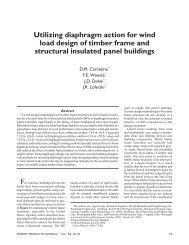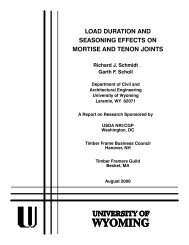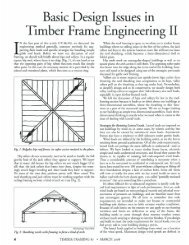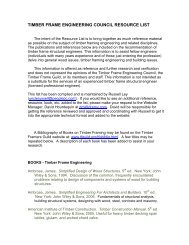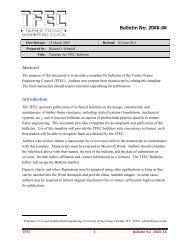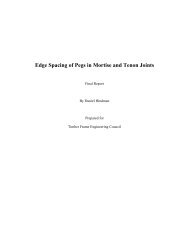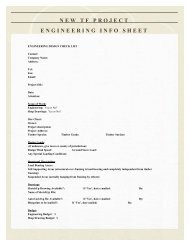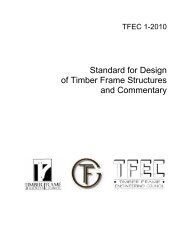Timber Frame Tension Joinery - Timber Frame Engineering Council
Timber Frame Tension Joinery - Timber Frame Engineering Council
Timber Frame Tension Joinery - Timber Frame Engineering Council
Create successful ePaper yourself
Turn your PDF publications into a flip-book with our unique Google optimized e-Paper software.
sample was removed from the base material. These were measured using calipers, weighed,<br />
and placed in an oven. After more than 24 hours, the samples were removed and weighed<br />
again to obtain the moisture content and the specific gravity.<br />
The test fixture held an oak peg securely to a steel base plate so that the base material<br />
could be placed on the peg, under the loading head (see Figure 4-5). The load rate for the<br />
dowel bearing tests was 0.02” per minute.<br />
Preliminary tests were performed in previous research (Schmidt et al., 1996) using<br />
White Oak pegs and Douglas Fir base material. The peg diameters were ¾”, 1” and 1¼”,<br />
with 18 1” pegs tested and six each of the ¾” and 1¼” pegs. The pegs were tested in the<br />
radial and tangential orientations. The blocks were tested in a variety of orientations. These<br />
orientations are labeled RL, LR, LT, and TR (see Figure 4-6). The two characters refer to<br />
the direction the load is applied and the orientation of the peg. For instance, the LT block<br />
orientation has the load applied in the longitudinal direction of the block with the axis of the<br />
peg parallel to the tangential axis of the block (see Figure 4-5 and Figure 4-6).<br />
Figure 4-5 Dowel Bearing Test Fixture<br />
35




